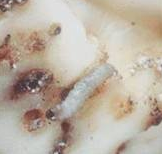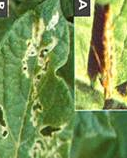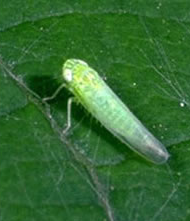 Greasy Cutworm/ Black cut worm: Agrotis ipsilon Greasy Cutworm/ Black cut worm: Agrotis ipsilon
| Symptoms of damage |
- Young larvae feed on the epidermis of the leaves.
- Older larvae come out at night and feed young plants by cutting their stems
- They also damage the tubers by eating away part of them.
|
| Identification of pest |
Eggs
- Creamy white, dome-shaped eggs, laid singly on lower surface of the leaves
Larvae
- Newly emerged young larva is yellow in colour
- The full-grown larva is dark or dark brown with a plump and greasy body.
Pupa
- Dark brown pupae are found in earthen cells lying underground in the potato fields.
Adult Moth
- Dark with some grayish patches on the back and dark streaks on the forewings.
|
Larva
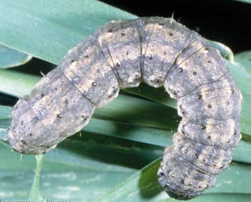
|
Adult

|
|
| Management |
- Flood the infested fields.
- Hand –pick and destroy the larvae – morning and evening hours on cracks and crevices in the field
- Plough the soil during summer months to expose larvae and pupae to avian predators
- Set up light trap @ 1/ ha
- Pheromone traps @ 12/ ha to attract male moths
- Spray insecticides like chlorpyriphos 20EC @ 1 lit/ha or neem oil @ 3%
|
Top
 Potato tuber moth: Phthorimaea operculella Potato tuber moth: Phthorimaea operculella
| Symptoms of damage |
- It is a pest of field and storage
- Larva tunnels into foliage, stem and tubers
- Galleries are formed near tuber eyes
|
|
| Identification of pest |
- Egg - laid singly –the ventral surface of foliage and exposed tubers.
- Larva - Yellow coloured caterpillar with dark brown head.
- Pupa: Pupation occurs within a cocoon among the trash, clods of the earth in the field.
- Adult: Small narrow winged moth, greyish brown forewings and hind wings- dirty white.
|
Larvae
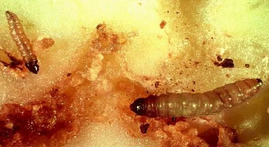
|
Adult
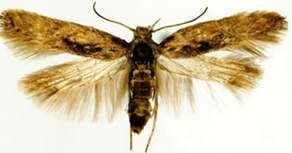
|
|
| Management |
-
Select healthy tubers
-
Avoid shallow planting of tubers. Plant the tubers to a depth at 10 - 15 cm deep.
-
Install pheromone traps at 15/ha.
-
Collect and destroy all the infested tubers from the field
-
Do not leave the harvested tubers in the field overnight
-
Adopt intercropping with chillies, onion or peas
-
Do earthing up at 60 days after planting to avoid female moths laying eggs on the exposed tubers
-
Cover the upper surface of potato tubers with the branches of Lantana and Eupatorium to repel the ovipositing moth in the godown
-
Release egg larval parasitoid: Chelonus blackburnii @ 30,000/ha twice – 40 and 70 day after planting
-
Spray NSKE @ 5% or quinalphos 25 EC @ 2ml/lit of water to manage foliar damage
-
Spray Bacillus thuringiensis @ 1 kg /ha at 10 days interval
|
Top
 White grubs: Holotrichia sp. White grubs: Holotrichia sp.
| Symptoms of damage |
- Grubs feed on roots and tubers
|
| Identification of pest |
- Larva:
‘C’ shaped grub
Adult
Brown beetle with pale prothorax
|
| Management |
- Summer ploughing to expose pupae
- Quinalphos 5% Dust @ 25 kg/ ha – 10 days after first summer rain
- Set up light trap @ 1/ha between 7 PM and 9 PM
- Hand – pick adult beetles in the morning.
|
Top
 Tobacco Caterpillar: Spodoptera litura Tobacco Caterpillar: Spodoptera litura
| Symptoms of damage |
- The young larvae first feed gregariously and scrape the leaves.
- Older larvae spread out and may completely devour the leaves resulting in poor growth of plants.
|
| Identification of pest |
-
Egg: -masses appear golden brown
-
Larva: - pale greenish with dark markings
-
Gregarious in the early stages
- Adult
- Forewings – brown colour with wavy white marking
- Hind wings- white colour with a brown patch along the margin
|
Larva

|
Adult
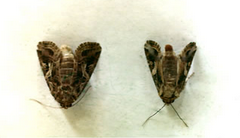
|
|
| Management |
-
- Plough the soil to expose and kill the pupae
- Grow castor along border and irrigation channel as trap crop
- Flood the field to drive out the hibernating larvae
- Set up light trap @1/ha
- Pheromone traps (Pherodin SL) @ 15/ ha to attract male moths
- Collect and destroy egg masses in castor and tomato
- Hand pick grown up larvae and kill them
- Spray Sl NPV @ 1.5 X 1012 POBs / ha + 2.5 Kg crude sugar + 0.1 % teepol
Poison bait
-
Rice bran 5 Kg + Molasses or Brown sugar 500g + Carbaryl 50 WP 500g+ 3lit of water/ha
-
Mix the ingredients well – Kept around the field in the evening hours
-
Spray chlorpyriphos 20 EC 2lit/ha or dichlorovos 76 WSC 1 lit/ha
|
Top
 Green Leaf Hopper Empoasca kerri Green Leaf Hopper Empoasca kerri
| Symptoms of damage |
- Tips of affected leaves become brown, turn upwards and get dried up
|
| Identification of pest |
- Egg - elongated yellow-white egg is deposited in leaf vein.
- Nymph - Pale – green, wedge shaped
- Winged pads extend up to the fifth abdominal segment.
- Adult
|
|
Top
 Green peach aphid: Myzus persicae Green peach aphid: Myzus persicae
| Symptoms of damage |
- Aphids suck sap of plants, as a result of which leaves turn pale and dry up.
- This pest also transmits various viral to potato plants.
|
Top
 Whitefly: Bemisia tabaci Whitefly: Bemisia tabaci
| Symptoms of damage |
- Nymphs suck sap from the leaves and lower their vitality.
- Yellowing and curling of leaf
- Sooty mould develops on affected leaves
|
| Identification of pest |
-
Egg
-
It is smooth, sub elliptical, stalked at broader basal end.
-
Its colour is light yellow, when freshly laid, turn dark brown later on.
Nymph
Adult
|
Top |




